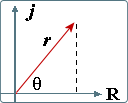IntMath Newsletter: MAM, modulus of complex number, Google Solve for x
By Murray Bourne, 03 Apr 2012
3 Apr 2012
In this Newsletter:
1. April is Math Awareness Month
2. Modulus or absolute value of a complex number?
3. Google's "Solve for <x>"
4. IntMath Privacy Statement
5. Math puzzle
6. Friday math movies
7. Final thought - Tenant farmers
1. April is Math Awareness Month
|
|
The theme for this year's Math Awareness Month is Mathematics, Statistics, and the Data Deluge. It's a great theme, since so many people are producing a mountain of new data every day. And there are some really good job opportunities for you in this - data analysis will be huge for the foreseeable future. |
2. Modulus or absolute value of a complex number?
 |
A reader challenges me to define modulus of a complex number more carefully. |
3. Google's Solve for <x>
This is an interesting initiative from Google. It's an invitation to suggest "radical technological solutions for today's big problems".
You can hear some insights by people who've already suggested good ideas, in TED-style talks.
This is the kind of thing we should be doing in schools to make learning more meaningful and relevant! Is there space for it in your school?
The link: Solve for <x>
4. Updated IntMath Privacy statement
You probably hear endlessly about privacy updates from Facebook, Google and other sites.
Well, I keep certain information about you too, my faithful readers. The updated IntMath Privacy Statement indicates what that information is, and how it is used.
Brief summary: I never share your private information with anyone, ever.
5. Math Puzzle
There were many "correct" answers for last Newsletter's math puzzle about birds and beasts. Special mention goes to all those (too many to mention) who showed full working - that's a very good habit to get into!
But here's the thing. In the "real" world, nothing is ever as straightforward as it seems (especially when considering typical math text book questions).
Some of the respondents considered there may be more to the question. Take Guido's comment "Birds are animals, too", and gfrblxt who amusingly said "Assuming that the zoo had no push-me pull-yous ^_^ ".
Devin included an excellent feature in his answer - he stated the assumptions for his solution (always a good thing to do when solving problems):
"Assuming all animals have 1 head, each beast has 4 feet and birds have 2."
Ricky, Anthonette and Alex also stated their assumptions, making their answers much more "correct".
But Tomas thought about it some more and began with:
Assuming snakes, snails, fish, and all other footless beasts are excluded...
Now, the original question used both of the terms "beast" and "animal" and for most of us, that means "tiger", "elephant" and so on. But strictly, an animal is any living creature belonging to the kingdom "Animalia", which includes 6-legged insects, 8-legged spiders, many-legged millipedes, and even zero-legged fish and sponges.
While we wouldn't call most of those "beasts", they are certainly not plants!
How about chimpanzees and other apes? They use all four limbs for walking, but we generally don't say they have 4 feet. Kangaroos are another example of a 4-limbed "beast" with only 2 feet.
As for the number of feet birds have, we won't even consider here Leviticus 11:20, where a few translations have "All fowls that creep, going upon all four, shall be an abomination unto you."!
All this makes the question a bit more difficult to answer! Of course, the question writer had the simple case in mind so the answers given are fine.
The bottom line is, when answering any math question that involves the "real" world, it's a good idea to think about what else could be included and what should be excluded - and then state your assumptions.
For the teachers who have read this far, math questions should probably be either clearly "close-ended" (all assumptions are stated in the question, and students should aim for the one correct answer), or (better), more "open-ended", like "real" problems, where the process of thinking through the possibilities makes it more interesting, more motivating and more useful for developing future problem-solving skills.
New puzzle: (This puzzle is close-ended and has only one correct answer - promise!)
What is the coefficient of x99 in the expansion of
(x − 1)(x − 2)(x − 3) ... (x − 100)?
You can add your answer here.
6. Friday math movies
 |
(a) The real meaning of MPH Here's an agonizing video demonstrating how we really should spend more time on fundamental concepts in math class. |
 |
(b) Calculus Rhapsody This is clever - and funny: a calculus parody of the classic Queen song, Bohemian Rhapsody. |
 |
(c) Inspirations - animation of Escher art Here's a celebration of Escher, and it includes many crucial math concepts. |
7. Final thought - Tenant farmers
Inventor and businessman Thomas Edison held over 1,000 patents for inventions ranging from the lightulb to the phonograph. He founded General Electric, an energy, technology and finance conglomerate.
His view on renewable resources is very interesting:
We are like tenant farmers chopping down the fence around our house for fuel when we should be using Nature's inexhaustible sources of energy - sun, wind and tide... I'd put my money on the sun and solar energy. What a source of power! I hope we don't have to wait until oil and coal run out before we tackle that. [Thomas Edison (1847-1931)]
Until next time, enjoy whatever you learn.
See the 21 Comments below.

3 Apr 2012 at 11:05 pm [Comment permalink]
-5050
3 Apr 2012 at 11:30 pm [Comment permalink]
What is the coefficient of x99 in the expansion of
(x - 1)(x - 2)(x - 3) ... (x - 100)?
AnS -5050
4 Apr 2012 at 1:22 am [Comment permalink]
What is the coefficient of x99 in the expansion of
(x - 1)(x - 2)(x - 3) ... (x - 100)?
My answer is: -5050
4 Apr 2012 at 3:02 am [Comment permalink]
Coefficient of x^99 is -5050.
4 Apr 2012 at 4:28 am [Comment permalink]
Coeff of x^99 is 1.
4 Apr 2012 at 4:32 am [Comment permalink]
-4950 will be the coefficient. It is the negative of the 99th triangular number. Take the number of factors minus 1 to tell you which triangular number to use. I just noticed a pattern.
4 Apr 2012 at 5:10 am [Comment permalink]
Assume: n = number of factors
Let's calculate (X-1)(X-2) ; (X-1)(X-2)(X-3) ; and so on.
The coeff. of the (n-1)th power of X are -3;-6;-10;...
These numbers can be found in the triangle of Pascal as:
(3);(4);(5);...
1 2 3
Or in general:( n )
n-2
All we have to do now is calculate for n=100
100! 100.99.98! 100.99
---- = ---------- = ------- = 4950
98! 2.98! 2
4 Apr 2012 at 5:16 am [Comment permalink]
It's -5050. (I misread the triangular numbers chart on a previous post!)
4 Apr 2012 at 7:48 am [Comment permalink]
So the coefficient is -4950.
sorry for the mixed-up layout.
4 Apr 2012 at 8:40 am [Comment permalink]
The answer is -5050, which is the sum of the first 100 integers with negative sign. This (i.e., that the coefficient of x to the n-1 in the product of n factors of the form (x - i), for i = 1,...,n, is the sum of the first n integers with negative sign) may be proved for any integer n. The proof proceeds by finite induction, considering that the product of the first n such factors is a polynomial of degree n. The details of the proof are straightforward, but require writing a few algebraic formulas which I can't do here.
4 Apr 2012 at 9:36 am [Comment permalink]
The coefficient of x^99 is the sum of whole numbers between (and including) -1 and -100, which is the negative triangular number of 100. The answer is -100*(100+1)/2 = - 5050.
4 Apr 2012 at 1:37 pm [Comment permalink]
From theory of equations we know (x-a)(x-b)=x^2 -(a+b)x+ab
we can extent this result (x-a)(x-b)(x-c)....(x-n)=x^n -(a+b+c+...n)x^(n-1)+....
Therefore here 1+2+3+...100=5050 it is the coefficient of x^99
4 Apr 2012 at 2:15 pm [Comment permalink]
My answer to the puzzle is:
-5050 as the coefficient of x99 in the expansion of
(x - 1)(x - 2)(x - 3) … (x - 100).
My TI-89 can do this but it takes a really really long time!!! I just entered it as the Product symbol (x-a), a, 1, 100) and it took about 6 or 7 mins before the answer came back, although it was just the complete factored polynomial without the expansion, not giving the coefficients, just as the question gave it but complete!
I tried again with the expand command and waited... (12 mins)... and all I got back was "< >" !! This means that, I'm assuming, that the answer will not fit on the screen!!
Well I then went to my copy of Mathematica ver. 4.0 and tried the same thing. It took less than a second for the factor product and then Expand[%] and the answer returned in less than a second again with every digit of every coefficient of every term!!!!!! INCREDIBLE! I love the power of this math software!!! If only I could have this power in a handheld portable unit like a calculator. I wouldn't need anything else. 😉
Now, I don't have any idea how to do this without the brute force method or turning to software. I'm 41 years old and just love doing math puzzles. I only have high-school math and the rest of my knowledge is all self taught.
I look forward to your review of the answers and how they were obtained!
Craig.
4 Apr 2012 at 5:46 pm [Comment permalink]
What is the coefficient of x99 in the expansion of
(x - 1)(x - 2)(x - 3) … (x - 100)?
It is simply 5050
4 Apr 2012 at 10:59 pm [Comment permalink]
-(1+2+...100)= - 100(100+1)/2 = -5050
6 Apr 2012 at 1:40 pm [Comment permalink]
Ans 198
7 Apr 2012 at 7:33 am [Comment permalink]
What is the coefficient of x^99 in the expansion of
(x-1)(x-2)(x-3) … (x-100)?
Temporarily change the problem to
What is the coefficient of x^100 in the expansion of
x(x-1)(x-2)(x-3) … (x-100)?
It can be shown that the coefficient of x^2 in
x(x-1)(x-2) is the same as the coefficient of x^2 in
(x-1)^3 . Note three terms and raising the middle term to the power of 3.
It can also be shown that the coefficient of x^4 in
x(x-1)(x-2)(x-3)(x-4) is the same as the coefficient of x^4 in (x-2)^5. Note five terms and raising the middle term to the power of 5.
Therefore I conclude that the coefficient of x^100 in the expansion of x(x-1)(x-2)(x-3) … (x-100) is the same as the coefficient of x^100 in (x-50)^101. Note 101 terms and raising the middle term to the power of 101.
By using the Binomial Theorem the coefficient of x^100 in the expansion of (x-50)^101 is -5050.
Therefore in the original question the coefficient of x^99 is -5050
10 Apr 2012 at 4:55 am [Comment permalink]
Oeps!!! Mistake
In general must be :
-(n+1)
n-1
So the coef. indeed is:
-(101)
99
-101!/(2!.99!) = -5050
11 Apr 2012 at 5:48 pm [Comment permalink]
when equation is quadratic of the form:(x^2)+bx+c;
b=-(sum of the two zeroes)
when equation is cubic of the form:(x^3)+b(x^2)+cx+d;
b=-(sum of the three roots)
........
........
So when equation is of the degree 100 & of the form:
x^100+b(x^99)+....+(some const)
Then;b=-(sum of the 100 roots)
Now the given expression is a factorized form of a 100-degree polynomial;which when put equal to zero gives roots 1,2,3,...,100
so the coeff of the 2nd term b here is=-(1+2+..+100)=-5050
13 Apr 2012 at 8:18 pm [Comment permalink]
answer is -5050 (since 1+2+3+...+100=5050).
18 Apr 2012 at 6:03 pm [Comment permalink]
Problem: Find a two digit number such that the number is equal to the square of the ten’s digit plus the square of the sum of the digits
My solution:
Let x be the ten’s digit and y be the unit’s digit.
Then the number is 10x + y
x^2 + (x + y) ^2 = 10x + y (given).
Therefore x^2 + x^2 + 2xy + y^2 = 10x + y
Therefore 2x^2 + 2xy + y^2 = 10x + y
We now substitute 0, 1,….9 for y and solve the quadratic in x
If we substitute 0 for y we get x = 5 yielding 10x + y = 50 as a solution
If we substitute 1 for y we get x = 4 or 0 yielding 10x + y = 41 as a solution (must be a two digit number, so 10x + y = 01 is inadmissible though mathematically valid)
Substituting 2 to 9 for y yields no integer solutions for x.
So there are two answers, 41 and 50.